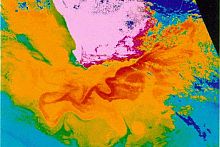SA's space agency prepares for liftoff
|
South Africa is beginning to make its presence felt on the international space radar screen.
In December last year, South African President Kgalema Motlanthe signed a Bill into law that will see the creation of South Africa’s own Space Agency.
The National Space Agency Act will pull together all space-related activities under one banner, and will provide for the establishment of a national Space Agency to be realised in the second half of this year to implement a viable and sustainable space programme in South Africa.
According to Dr Val Munsami, General Manager: Space Science & Technology of the Department of Science and Technology, the enactment of the law “is sending a message to the world that the country is ready and capable of providing for its national space needs and to engage in the international community”.
South African astronomers, working at the South African Astronomical Observatory, the Hartebeesthoek Radio Astronomical Observatory and various universities, have access to some of the largest facilities for astronomy in the world.
The Southern African Large Telescope at Sutherland in the Northern Cape is the largest single optical telescope in the southern hemisphere. South Africa is also bidding to host the Square Kilometre Array, one of the most important and most exciting projects proposed for radio astronomy in the past 50 years.
According to Mosibudi Mangena, Minister of Science and Technology the existing infrastructure and skilled workforce in these facilities, as well as in the wider industry supporting them, could serve as a basis for strengthening ties with industry in established space-faring nations. He also mentioned the possibility of developing links with other emerging national space initiatives, particularly in Africa, positioning South Africa as a regional hub for space science and technology.
National Space Strategy
The Space Agency will be responsible for implementing the National Space Strategy, which was approved by Cabinet in December last year, to stimulate the capability to place South Africa among the leading nations in the innovative use of space science and technology. The strategy is aimed at leveraging the benefits of space science and technology for socio-economic growth and sustainable development.
The strategy was derived from the DST’s Ten Year Innovation Plan, which includes space science and technology as one of five grand challenges
In implementing the strategy, the agency will promote the peaceful use of outer space, foster research in astronomy, earth observation, communications, navigation and space physics, foster international cooperation in space-related activities, and advance scientific, engineering, and technological competencies through human capital development.
Three key priority areas have been identified: environmental resource management; health, safety and security; and innovation and economic growth.
Implications for SAEON
"Man must rise above the Earth – to the top of the atmosphere and beyond – for only then will he fully understand the world in which he lives. " - Socrates, ca. 450 BC
According to Dr Munsami the agency will be working closely with SAEON in environmental resource management and Earth observation, one of four thematic areas that have been identified as vital for a viable space programme.
Minister Mangena has emphasised that, “Earth observation will become one of the central pillars of the new agency. Our goal is to make South Africa a global player in the Earth observation satellite domain, and this includes ongoing participation in initiatives such as Global Monitoring for Environment and Security (GMES), the Group on Earth Observation (GEO), African Resource and Environment Management Satellite Constellation (ARMC), the international disaster charter, and others.”
Earth observation will focus on two key missions - understanding the planet, and providing data for decision-making. These missions are to be developed in support of implementing South Africa's Earth Observation Strategy (SAEOS).
Key factors in environmental resource management have been identified in the strategy as environmental and geospatial monitoring; ocean, coastal and marine management; land management; rural development and urban planning; topographic mapping; hydrological monitoring; climate change mitigation and adaptation; and meteorological monitoring.
Societal benefits
The benefits from space infrastructure are becoming more evident in the management of long-term and significant challenges faced by modern society.
“Space activities have had, and continue to have, a positive and beneficial impact on everyday life and society. Despite the high costs of space activities there are tremendous returns to the community in terms of job creation, technological know-how, scientific knowledge, and space spin-offs,” remarks Dr Munsami.
Next steps
According to Science and Technology Minister Mosibudi Mangena all the fundamentals for the new agency are in place, except for the board. Shortly after the April 22 general elections, efforts will be intensified to put a board together and get the agency operational.












